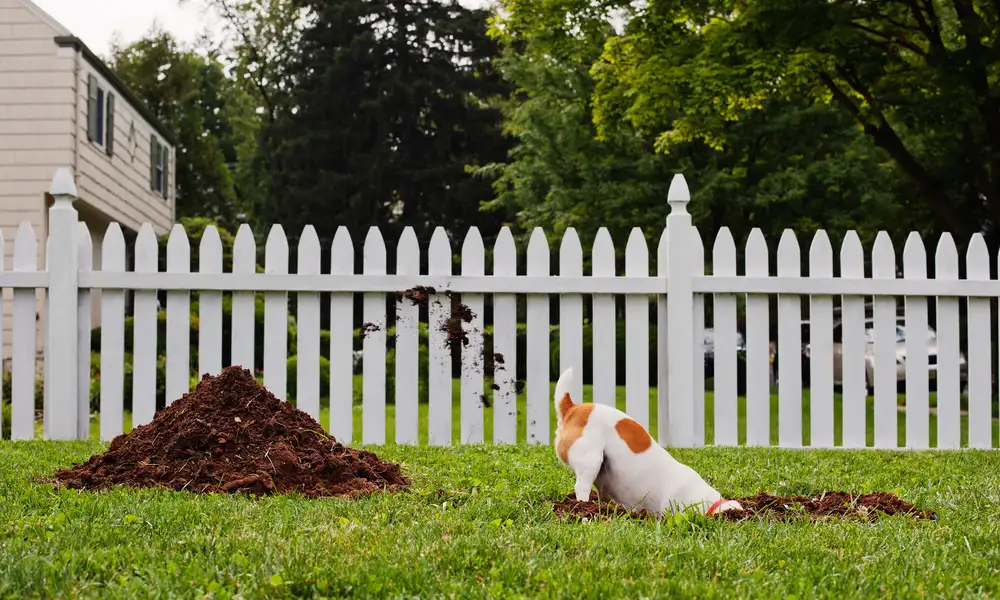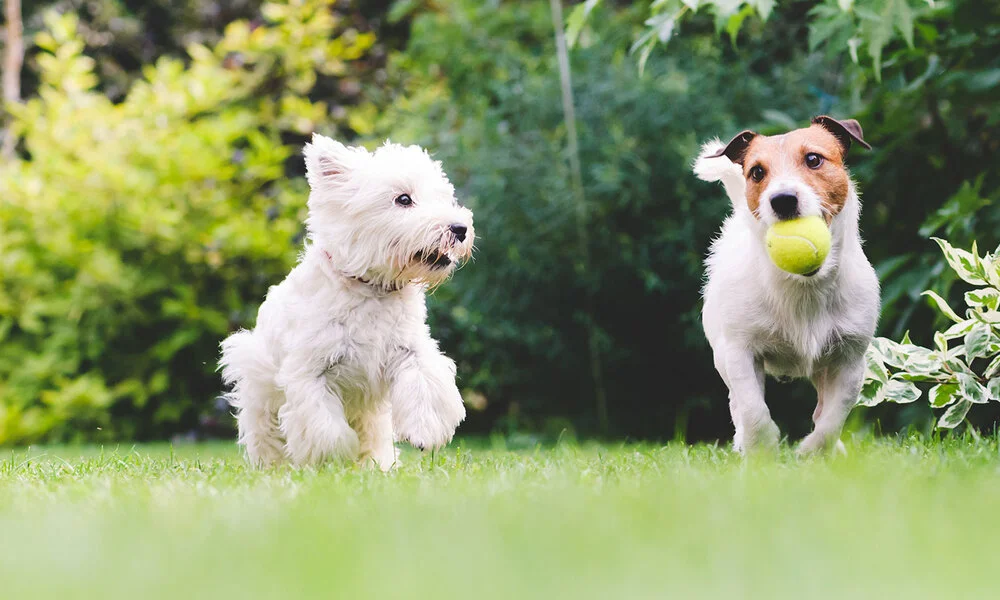How to keep dogs off your lawn is a common concern for many homeowners who want to maintain a clean, damage-free yard. Whether it’s neighborhood pets wandering through or stray animals leaving behind messes, dealing with this issue can be frustrating. Fortunately, there are several effective methods for repelling dogs from lawn areas without causing them harm. From using natural deterrents and motion-activated sprinklers to installing physical barriers or applying pet-safe repellents, these solutions can help you keep dogs off lawn spaces and protect your landscaping. With the right approach, you can enjoy a beautiful, dog-free yard all year round.
Why You Should Keep Dogs Off Your Lawn

Your lawn is more than just grass it’s part of your home’s beauty, investment, and first impression. Allowing dogs to roam freely on your grass may seem harmless, but the long-term effects can be costly and frustrating. Here’s why keeping dogs off your grass is not only a smart move but a necessary one.
1. Damage Caused by Dog Urine and Digging
Dog urine contains high levels of nitrogen, which can burn grass and create unsightly yellow or brown spots. Over time, these patches multiply, weakening your turf’s health and appearance. Even worse, dogs often choose the same spot repeatedly, causing compounding damage.
In addition to urine damage, digging is another common issue. Some dogs instinctively dig into soft soil, especially if they pick up the scent of another animal. This leads to uneven ground, uprooted plants, and a lawn that’s more dirt than grass.
Using humane methods to repel dogs from yard spaces can help preserve your lawn’s quality and appearance. Solutions like motion-activated sprinklers, dog-safe repellents, and boundary barriers are effective tools.
2. Health and Hygiene Concerns
Dog feces aren’t just an eyesore they pose serious health risks. They can carry harmful bacteria, parasites like hookworms or roundworms, and even viruses. If children play on the lawn or you host outdoor gatherings, exposure to these contaminants becomes a real concern.
Also, urine and feces attract pests and can cause a foul odor, which affects the overall hygiene and enjoyment of your outdoor space. Keeping dogs off your grass helps ensure your lawn remains clean, safe, and suitable for your family’s use.
3. Impact on Landscaping and Curb Appeal
A professionally maintained lawn with clean edging, healthy turf, and decorative plants is a strong statement of curb appeal. But all of that effort can be undone if dogs frequently trample through your yard. They can knock over decorative lights, crush delicate ground covers, and even harm ornamental shrubs by urinating on them.
Homeowners invest significant time and money into landscaping. Allowing untrained or unsupervised dogs on your property can reverse that progress quickly. To protect your investment, take proactive steps to repel dogs from yard entry points.
4. Neighborhood Disputes and Legal Considerations
Allowing dogs to wander onto others’ property often leads to neighborhood tension. If someone’s pet damages your lawn or leaves behind waste, it may create uncomfortable conversations or worse, legal action.
Depending on your local laws, homeowners may have the right to install fencing, post signs, or take legal steps to enforce keeping dogs off your grass. Being proactive about setting boundaries helps avoid misunderstandings and keeps neighborhood relationships positive.
You may read about How Much Lawn Care Cost?
DIY Dog Repellent Sprays to Keep Dogs Off Lawn
Repelling dogs from lawn areas can be done naturally using DIY dog repellent sprays. These simple, homemade solutions use everyday ingredients like vinegar, citrus, and essential oils to help keep dogs off lawn spaces without causing harm. Whether you’re dealing with neighborhood pets or your own curious pup, these recipes are easy, affordable, and effective.
Natural Ingredients for Repelling Dogs from Lawn
Dogs have sensitive noses, and strong smells like vinegar, citrus, and certain essential oils can deter them. These natural substances don’t just repel dogs they’re also safe when used properly. When sprayed around garden edges, pathways, and entry points, they help discourage unwanted visits without using harsh chemicals.
Recipe #1: Vinegar & Lemon Spray
This spray combines the strong scent of vinegar with the acidic aroma of lemon, both known for repelling dogs from lawn areas.
Ingredients:
- 1 cup white vinegar
- 1/2 cup freshly squeezed lemon juice
- 1 cup water
Instructions:
Mix all ingredients in a spray bottle. Shake well before each use. Spray along the edges of your lawn, garden beds, or any area you want dogs to avoid. Avoid spraying directly on plants, as vinegar can harm some vegetation.
Recipe #2: Cayenne Pepper & Water Mix
Cayenne pepper has a pungent scent and slight irritation that dogs avoid, making it effective for helping keep dogs off lawn zones.
Ingredients:
- 1 tablespoon cayenne pepper
- 1 quart of water
Instructions:
Mix the cayenne pepper into water and stir thoroughly. Pour the solution into a spray bottle and apply it around the perimeter of your lawn. Do not spray directly on dogs or in windy conditions to avoid eye irritation.
Safety Tips: What’s Safe vs. Harmful for Dogs
While natural repellents are generally safe, it’s important to use them responsibly:
- Vinegar and lemon: Safe in diluted forms but avoid overuse to prevent damaging grass or plants.
- Cayenne pepper: Effective for repelling dogs from lawn but should never be applied directly to pets or areas where they might sniff deeply.
- Essential oils: Some oils like citrus or eucalyptus can be irritating. Use them in small, diluted amounts and avoid tea tree oil, which is toxic to dogs.
Always monitor your dog’s reaction and adjust as needed to avoid distress.
How Often to Reapply and Where to Spray
Natural sprays lose potency over time, especially after rain or watering. Reapply every 2–3 days or after heavy moisture. Focus on spraying:
- Lawn borders
- Garden beds
- Entryways or walking paths
- Fence lines
Regular application helps reinforce boundaries and conditions dogs to stay away. Using these safe and simple sprays can be an effective part of your strategy for repelling dogs from lawn areas and maintaining a clean, damage-free yard. For Lawn care services in San Jose contact no other than Lakota Design Group.
5 Effective Ways to Keep Dogs Off Your Lawn

Repelling dogs from lawn areas can be a challenge, especially if neighborhood pets frequently roam into your yard. Whether you’re dealing with digging, urine spots, or general damage, it’s important to use humane and effective methods to keep dogs off lawn spaces. Below are five proven strategies that combine physical, sensory, and behavioral tactics to help repel dogs from yard and garden zones.
1. Physical Barriers: Fencing, Edging, or Plant Borders
One of the most straightforward ways to keep dogs off lawn sections is by installing physical barriers. A low picket fence, decorative edging, or thick plant borders like boxwood or holly can help define boundaries and deter dogs from entering. These methods are effective for repelling dogs from lawn edges and garden beds without being aggressive or harmful.
2. Motion-Activated Devices: Sprinklers and Ultrasonic Repellents
Motion-activated devices are an excellent hands-off method to repel dogs from yard areas. Sprinklers startle intruding animals with a harmless burst of water, while ultrasonic repellents emit high-frequency sounds that are unpleasant to dogs but inaudible to humans. These tools help enforce invisible boundaries and are especially useful in open yards where fencing isn’t possible.
3. Scent-Based Deterrents: Commercial Sprays and Ammonia
Dogs rely heavily on their sense of smell, which makes scent-based repellents highly effective. Commercial dog repellent sprays and homemade solutions using vinegar or ammonia can discourage dogs from specific spots. Apply these around trash bins, flower beds, or lawn corners to help with repelling dogs from lawn zones where they tend to linger.
4. Training & Signage: Clear Communication
Simple signs like “No Dogs Allowed” or “Please Keep Pets Off the Lawn” can remind neighbors to keep their pets in check. If stray dogs are an issue, consider having a friendly conversation with nearby dog owners. Positive community communication, along with consistent reinforcement, can go a long way in helping keep dogs off lawn areas and reducing repeat offenses.
5. Strategic Landscaping: Natural Dog Deterrents
Some plants naturally repel dogs due to their strong scent or texture. Landscaping with dog-deterring plants like lavender, rosemary, or marigolds can create natural barriers. You can also use gravel, mulch, or pinecones in certain areas to make them less appealing for digging or lounging. This approach combines aesthetic appeal with functionality, making it easier to repel dogs from yard spaces while enhancing your outdoor design.
By combining these five methods, you can create a lawn that’s both beautiful and dog-resistant. Whether it’s through physical design, sensory deterrents, or neighborly cooperation, these tips will help you succeed in repelling dogs from lawn areas and maintaining a well-kept yard.
When To call professionals
If you’re constantly dealing with dogs entering your property, causing repeat damage, or your lawn shows signs of heavy wear despite trying multiple DIY solutions, it may be time to call in professionals. Large-scale dog intrusion, persistent yellow patches, or torn-up soil are strong indicators that expert help is needed. Lakota Design Group offers tailored lawn care and landscape solutions that can help with repelling dogs from lawn areas while restoring the beauty of your yard. From strategic landscaping to barrier installation, our team ensures long-term protection. For pet owners, consulting an animal behaviorist may also be helpful in correcting habits. In some cases, checking local ordinances can offer legal solutions. Ready to take control of your yard? Call Lakota Design Group at (408) 826-2888 for expert support and lasting results.
FAQs
Q1: What Are The Most Effective Ways To Keep Dogs Off My Lawn?
To keep dogs off lawn areas, use a mix of physical barriers like fencing, scent-based repellents such as vinegar sprays, motion-activated sprinklers, and strategic landscaping. Combining multiple deterrents is the most effective method for repelling dogs from lawn and garden zones.
Q2: Do Natural Dog Repellents Really Work For Yards And Lawns?
Yes, natural repellents like citrus, vinegar, and cayenne pepper sprays can successfully repel dogs from yard spaces. They work by irritating a dog’s sensitive nose, making them avoid treated areas without causing harm.
Q3: How Can I Stop Neighborhood Dogs From Entering My Yard?
To repel dogs from yard perimeters, install fences or use motion-activated sprinklers. You can also place “No Dogs Allowed” signs and politely talk to neighbors. For repeat intrusions, applying scent-based deterrents regularly around borders can help keep dogs off lawn areas.
Q4: Are Commercial Dog Repellents Safe For My Lawn And Plants?
Most commercial dog repellents are formulated to be lawn-safe. However, always check labels for pet and plant safety before use. For eco-friendly alternatives, natural sprays like diluted vinegar or citrus can help with repelling dogs from lawn zones.
Q5: Can Certain Plants Help Keep Dogs Away From The Lawn?
Yes, planting dog-repelling plants like lavender, rosemary, and marigolds can help naturally keep dogs off lawn spaces. These plants release strong scents that dogs dislike, making your yard less inviting.